Back to Venus again
TIMELINE: 1979-1981
The pace of planetary exploration slowed considerably after 1978, particularly in the US. There were no launches to the Moon or the planets in 1979-80. ft was a striking contrast to the hectic 1960s and 1970s. Tn fact there would be no lunar or planetary launches by the IJS during the eleven years between 1978 (Pioneer Venus) and 1989 (Galileo). Continuing their assault on Venus using the successful Venera spacecraft, the Soviets had the field to themselves. At the next Venus opportunity in 1981 they launched another pair of Venera flyby/’landcrs. Both were successful, and this time produced the first color images of the surface of the planet.
Launch date
1979
No missions
1980
No missions
1981
30 Oct Venera 13 flyby/landcr Success, first color images from surface
4 Nov Venera 14 flyby/lander Success
COLOR PICTURES FROM THE SURFACE OF VENUS: 1981
Campaign objectives:
Venera 11 and 12 had not completed the goals set for them. Whilst the experiments carried out during the descent produced a prodigious amount of information on the
W. T. Huntress and M. Y. Marov, Soviet Robots in the Solar System: Mission Technologies and Discoveries, Springer Praxis Hooks 1, DOl 10.1007/978-1-4419-7898-1 16,
© Springer Science+Business Media, LLC 2011
atmosphere, the surface science was mostly a failure. The Soviets skipped a launch opportunity in order to develop new heat-resistant technologies in order to fix these problems. In 1981 they were ready to try again with better devices and instruments, principally aiming to obtain color images from the surface and to analyze a sample obtained by a drill. The landing sites were chosen in collaboration with US scientists using maps based on the radar imaging experiment perfonned by the Pioneer orbiter in 1978. ~
|
Spacecraft launched First spacecraft: Mission Type: Country: Builder: Launch Vehicle: Launch Dale ‘: 7 ime: Enc ounter DateiTime: Outcome: |
Venera 13 (4V-1M No.760) Venus Flyby/Lander USSR NPO-Lavochkin Proton-K October 30. 1981 at 06:04:00 UT (Baikonur) March 1,1982 Successful. |
|
Second spacecraft: Mission Type: Country j Builder: Launch Vehicle: Launch Date ‘: 7 7me: Encounter Date; ‘Lime: Outcome: |
Venera 14 (4V-1M No.761) Venus Flyby.’Lander USSR NPO-Lavochkin Proton-K November 4, 1981 at 05:31:00 UT (Baikonur) March 5, 1982 Successful. |
|
Spacecraft: |
As flyby spacecraft, Venera 13 and 14 were essentially identical to their immediate predecessors. The major changes for 1981 concerned the lander. In particular, metal teeth were added to the periphery of the impact ring in an effort to reduce the spin and oscillation during the descent and prevent the rough landings experienced by the 1978 missions. The camera lens cover problem was fixed, and the soil sampler was redesigned to alleviate the problem that disabled it on Venera 11 and 12.
|
Launch mass: 4,363 kg
|
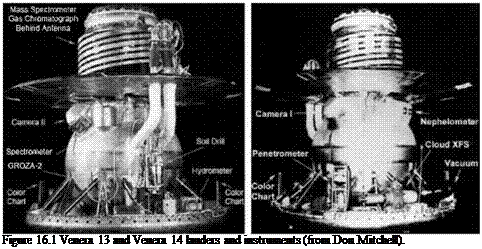 |
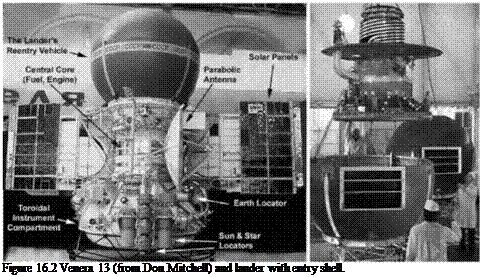 |
Payload
Flyby spacecraft
1. KONUS gamma-ray burst detector
2. SNEG gamma-ray burst detectors (France-USSR)
3. Magnetometer (Austria)
4. High energy particle cosmic ray detector
5. Solar wind detectors
The flyby spacecraft carried a reduced payload to facilitate an increased payload on ihc lander. Updated forms of the cosmic ray experiment and the two gamma-ray investigations were included, and an Austrian magnetometer on a 2 meter boom was attached to one of the solar panels.
Flyby payload mass: 92 kg Lander
Entry and descent
1. Accelerometers for atmospheric structure (110 down to 63 km) and then lander impact analysis
2. Temperature and pressure sensors
3. Gas chromatograph for atmospheric composition
4. Mass spectrometer for chemical and isotopic composition
5. Hydrometer for water vapor content
6. Nephclomcter for aerosol studies
7. X-ray fluorescence spectrometer for elemental composition of aerosols
8. Spectrophotometer for spectral and angular distribution of solar radiation
9. Ultraviolet photometer 320 to 390 nm
10. GROZA-2 radio for electrical activity and microphone for acoustic and seismic events
11. Doppler experiment for wind and turbulence Surface
1. Panoramic color imaging system with two cameras
2. Drill and surface sampler
3. X-ray fluorescence spectrometer for surface rock elemental composition
4. Rotating conical soil penetrometer (PrOP-V)
5. Chemical oxidation state indicator
Several of the instruments were improved from their Venera 11 and 12 versions, including the camera, drill, spectrophotometer, x-ray spectrometer for aerosols, mass spectrometer and gas chromatograph. The hydrometer humidity sensor and chemical oxidation state indicator were new; the latter being a simple chemical indicator to search for traces of oxygen in the atmosphere. The spectrophotometer measured the full spectrum from 470 to 1,200 nm using a wide-angle sky view and an array of six narrow-angle directional views. The gas chromatograph was equipped with a better detector, could sense more species, and was capable of operating in the cloud layer. l he mass spectrometer was improved to provide 2 to 40 times better mass resolution with 10 to 30 times greater sensitivity. The anomalous krypton reading of the 1978 missions was understood and corrected. The GROZA-2 instrument now; included a modified 10 kHz detector, a new7 detector in the 2 kHz band, and was better able to search for seismic events after touchdown.
The panoramic imaging system was fitted with an improved lens cover. The large increase in bandwidth for the transmission to the flyby relay spacecraft allowed each camera to have clear, red, green, and blue filters. Each camera was to cycle through its 180 degree panoramic image four times, one for each filter, taking almost an hour to complete. To ensure that a color section would be transmitted if the lander lasted only 30 minutes, one camera first scanned a full 180 degrees through the clear filter and then scanned each of three 60 degree sections in turn with red, green and blue filters.
It is a testament to the technology of the Venera landers that so many instruments were mounted outside and hence exposed to the pressure, temperature and corrosive atmosphere of Venus. These included the drill, penetrometer, mass spectrometer, gas chromatograph, hydrometer, aerosol x-ray spectrometer, oxidation state indicator, and the GROZA radio sensors and microphone. The cameras and nephelometer were mounted inside with special housings attached to the pressure vessel to enable them to observe out through windows and prisms. The platinum thermometer and aneroid pressure instrument used external sensors with wires fed through ihe pressure vessel.
The drill sampler was on the base of the lander. The machining of this device had to take account of thermal expansion at 500"C, and the process of drilling, sampling and analysis had to complete within the 30 minute guaranteed lifetime of the lander. A telescoping drill head was to bore into the surface for about 2 minutes, reaching as much as 3 cm into solid rock and coring a 2 cc sample. Information on the speed and
|
figure 16.3 Venera 13 and Venera 14 lander drill mechanism (from Don Mitchell). |
movement of the drilling rig. depth of drill penetration, and magnitude of the current drawn by the elec trie motor while drilling, provided information on the physical and mechanical properties of; the surface. After the few grams of material gained by the drill had been deposited on a tray, this would be moved pyrotechnically through a three-stage airlock to transfer it from the ambient 90 bar pressure to just 0.06 bar in the analysis chamber of the x-ray fluorescence spectrometer, which used plutonium, uranium-235 and iron-55 sources. The gas pumping for this transfer was enabled by a vacuum reservoir on the base of the lander.
The dynamic penetrometer was designed to determine the mechanical properties of the surface material, whether rock or soil. It consisted of a cone-shaped die that could pivot on the end of a lever and fall forward onto the ground. Л sighting device within the field of view of one of the cameras determined the depth of penetration. After penetration, a spring would cause the die to rotate in the soil and the angle of its turn would be displayed on the sighting device. A cable unit was also attached to one end of the die and an electronic unit within the lander could measure electrical resistance.
Lander payload mass: 100 kg
Mission description:
Landers
Venera 13 was launched on October 30, 1981, and made midcourse corrections on November 10 and February 21, 1982. It released its entry capsule on February 27 at a range of 33,000 km from the planet, and this entered the atmosphere on March 1. The accelerometer was turned on at about 100 km altitude and provided data on atmospheric density until parachute deployment. The parachute opened at 62 km and was jettisoned about 9 minutes later at an altitude of; 47 km. The descent instruments were activated just after the parachute opened, and the descent time from parachute opening to landing was just over an hour. The lander hit at 7.5 m/s. bounced once, and came to rest on a fiat, crumbly surface in an elevated hilly landscape at 7.55 :S 303.69 :E. It was 03:57:21 UT, 09:27 Venus solar time, and the solar zenith angle was 36 degrees. The surface transmission lasted 127 minutes.
Venera 14 was launched on November 4, 1981. and required three midcourse corrections to reach Venus. This was because the first one on November 14 w as not executed properly. After a compensating maneuver on November 23, the final trim maneuver was made on February 25. 1982. The entry system was released on March 3, and this entered the atmosphere on March 5. The parachute opened at 62 km and w as jettisoned at 47 km. The lander touched down at about 7.5 m/s on a low lying plain at 13.055 S 310.19’E, 950 km southwest of; its partner. It was 07:00:10 UT, 09:54 Venus solar time, and the solar zenith angle was 35.5 degrees. The surface transmission lasted 57 minutes.
Venera 13 and 14 experienced the same electrical anomaly as had Venera 11 and 12 at 12.5 km altitude. The science sequences worked very well on descent for both
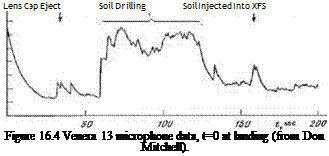
landers and also on the surface. Immediately upon landing, the lens covers popped off and imaging began. A black-and-white contingency image was transmitted first, followed by the color panoramas. The drill experiment was also started immediately after landing and the entire process of drilling, sampling, and analysis took a little over 32 minutes. Venera 13 obtained a 2 cc sample and Venera 14 obtained a 1 cc sample, each from a depth of 3 cm. The Venera 13 penetrometer worked well, but by bad luck on Venera 14 this experiment deployed on top of an ejected lens cover. The microphones picked up aerodynamic noise during the descent, the sounds of the landing, and then the deployment of the lens covers, the drilling noise and sampler pyrotechnics, winds at the site, and other sounds of the lander at work.
Flyby carrier spacecraft:
The flyby carriers each passed Venus at an approximate closest point of approach at
36,0 km and entered heliocentric orbit where they continued to return data on the Sun, including flares. As tests to assist in planning late midcourse maneuvers for the Halley’s comet encounters by the Vega missions, Venera 13 fired its engine on June 10, 1982, and Venera 14 did so on November 14, 1982.
Results:
Venera 13 lander:
Descent measuremen ts:
The microphysical properties reported by the nepheiometers indicted, three distinct layers in the main cloud system: a dense top layer from 60 km (the altitude at which the measurements began) down to 57 km, then a transparent layer from 57 to 50 km, and finally the densest layer from 50 to 48 km. Doppler measurements gave a wind profile. Interestingly, the humidity sensors on both Venera 13 and 14 indicated ten times more water in the atmosphere than was determined spectroscopically in the 46 to 50 km range. The water mixing ratio was determined from several instruments and, despite some conflicting values, it seemed to be greatest in the cloud formation
region between 40 and 60 km with less water above and below the cloud layers. The amount of water vapor at 48 km was estimated at 0.2%. The mass spectrometer was not opened until below the cloud layers to preclude it being clogged by aerosols, and it provided altitude profiles of a number of atmospheric constituents between 26 km and the surface. These findings include a neon isotope ratio slightly higher than for Earth but less than for the Sun, a small krypton mixing ratio significantly less than that measured by the gas chromatograph and by Venera 11 and 12, and an argon-40 mixing ratio about four times lower than for Earth. The gas chromatograph detected some new species including molecular hydrogen, hydrogen sulfide, and carbonyl sulfide. Other species detected included molecular oxygen, water vapor, krypton, and sulfur hexafluoride.
The coronal discharge detectors of the GROZA-2 experiment established that no vehicle discharges were responsible for the very low frequency bursts interpreted as lightning by the Venera 11 and 12 experiments. No lightning or electrical discharges were detected.
Surface measurements:
Venera 13 obtained both black-and-white and the first color panoramic images from the surface of Venus. These show the lander ring base with triangular ‘crown’ points for lander stabilization during the descent, the ejected camera covers, the color test pattern strips, the deployed PrOP-V penetrometer, and the exhaust port of the aerosol x-ray fluorescence instrument on the lander ringjusl to the left of the penetrometer. The landing site appeared to be composed of bedrock outcrops surrounded by dark, fine-grained soil. The Venera 13 and 14 panoramas both showed llat, layered stones with a dark soil between them, and scattered small grains to compose a scene reminiscent of the floor of a terrestrial ocean. The photometers noted dust raised by
|
Figure 16.5 Venera 13 lander hemisphere 1 color panorama (processing by Ted Stryk). |
|
Figure 16.6 Venera 13 lander hemisphere 2 color panorama (processing by Ted Stryk). |
the landing, but it quickly settled and the resulting sedimentation was apparent by comparison of sequential images through different filters.
The Venera 13 site showed dark, flat rocks distributed over a darker crumbled soil surfaee with some low, rolling ridges in the background. The cameras returned four panoramas each, one in each filter: clear, red. green and blue; the latter three for the color image. However, precise color balancing was difficult to achieve in processing the filter data because the deployed calibration strips were affected by heat, pressure, and the orange sky. and because the radiometric response of the camera was not well known.
The drill sample analysis indicated a potassium-rich basalt of a type that is rare on Earth. The penetrometer showed the load-bearing capacity of the soil to be similar to heavy clays or compacted dust-like sand. These are both consistent with the surface characteristics derived from stress-strain profiles measured in the mechanics of the landing, which indicated a surface covered by a weak, porous material similar to the properties of weathered basalt. The electrical resistivity of the surface was surprising low. in the semi-conductor range, perhaps due to a thin film of conducting material on insulating soil particles.
The exposed-surface chemical test on both landers for the oxidation state of the Venusian atmosphere seemed to indicate a reducing carbon dioxide-rich atmosphere instead of an oxidizing one, but the experiment may have been compromised by the dust disturbed upon landing. Due to the short lifetime on the surface, the GROZA-2 acoustic experiment was designed to detect the micro seismic events that commonly occur at a rate of about one every few’ seconds on Earth. No events were detected by Venera 13, but tw7o such events may have been noted by Venera 14. The Venera 13 microphone recorded the aerodynamic noise of the descent, and on the surface this data gave w ind speeds of 0.3 to 0.6 m/s. Successive pictures through different filters show ed dust being blown off the lander ring. The temperature at the landing site was 465°C and the pressure was 89.5 bar. Only 2.4% of sunlight reached the surface. Some minor changes in illumination were observed, perhaps due to clouds, but the overall impression was of a dead calm, murky atmosphere over a flat volcanic plain.
Venera 14 lander:
Deseent measurements:
 |
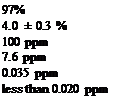 |
The Venera 14 lander conducted the same observations as Venera 13. both during its descent and w hile on the surface, obtaining very similar results. The combined mass spectrometer results were:
the isotopic ratios were:
 13/12 carbon 40/36 argon 38/36 argon 20/22 neon
13/12 carbon 40/36 argon 38/36 argon 20/22 neon
and the combined gas chromatograph results were:
 water vapor molecular oxygen molecular hydrogen krypton
water vapor molecular oxygen molecular hydrogen krypton
hydrogen sulfide carbonyl sulfide sulfur hexafluoride
The x-ray fluorescence instrument measured the composition of the aerosols from 63 to 47 km. It detected both sulfur (1.10 + 0.13 mg/m3) and chlorine (0.16 + 0.04 mg/mJ) and the chlorine abundance was considerably knver than the measurement by Venera 12. This more precisely calibrated instrument measured a sulfur/’chlorine abundance ratio compatible with sulfuric acid aerosols. The aerosols in the region between 6.3 and 47 km were composed principally of sulfur compounds with some chlorine compounds. The abundance ratio of sulfur and chlorine varied with altitude. The highest density aerosols were in the range 56 to 47 km. The x-ray fluorescence instrument of Venera 13 did not operate properly.
Surface measurements:
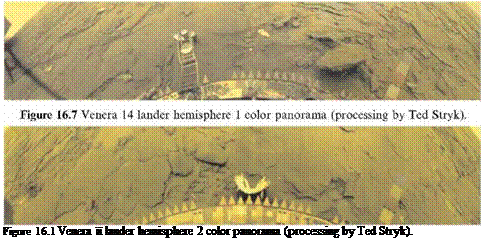 |
Unlike Venera 13, the Venera 14 photometers detected no dust raised on landing. It came down on a smooth level plain with flat, layered rocks which had very little soil
|
Figure 16.9 Venera 14 panoramas reprocessed to provide a horizontal human – perspective view (courtesy Ted Stryk). |
between them. The composition of the drill sample indicated a low-potassium basalt similar to that of terrestrial mid-ocean ridges. A lower sulfur content than Venera 13 may well indicate that the Venera 14 site is younger. The surface properties inferred from the dynamics of touchdown indicated a surface similar to the Venera 13 site, but possibly covered with a layer of weaker, porous material. No penetrometer data was obtained from Venera 14 because the instrument swung down onto a jettisoned lens cover. The audio sensor reported two sounds that could have been distant and small seismic events. The temperature at the site was 470=,C and the pressure was 93.5 bar. Hie amount of sunlight reaching the surface was 3.5%.
X-ray fluorescence soil analysis results were:
|
Venera 13 Venera 14
|
The surface composition measurements from Venera 8, 9, 10, 13 and 14 at sites around the planet were all consistent with basalts of compositions similar to those on Earth. The great variety of igneous and metamorphic rocks widespread on Earth was not evident, most likely owing to the lack of water on Venus.
Venera 13 and 14 flyby spacecraft:
Both ilybv spacecraft collected data on the solar wind and solar x-ray Hares. They participated in an interplanetary network to triangulate on gamma-ray bursts, in this case detecting about 150 events. Later in the decade, the Vega spacecraft were to use a flyby of Venus to set up an encounter with Halley’s comet, so after leaving Venus behind Venera 13 and 14 fired their engines to rehearse the maneuvers that would be required by those later missions.















